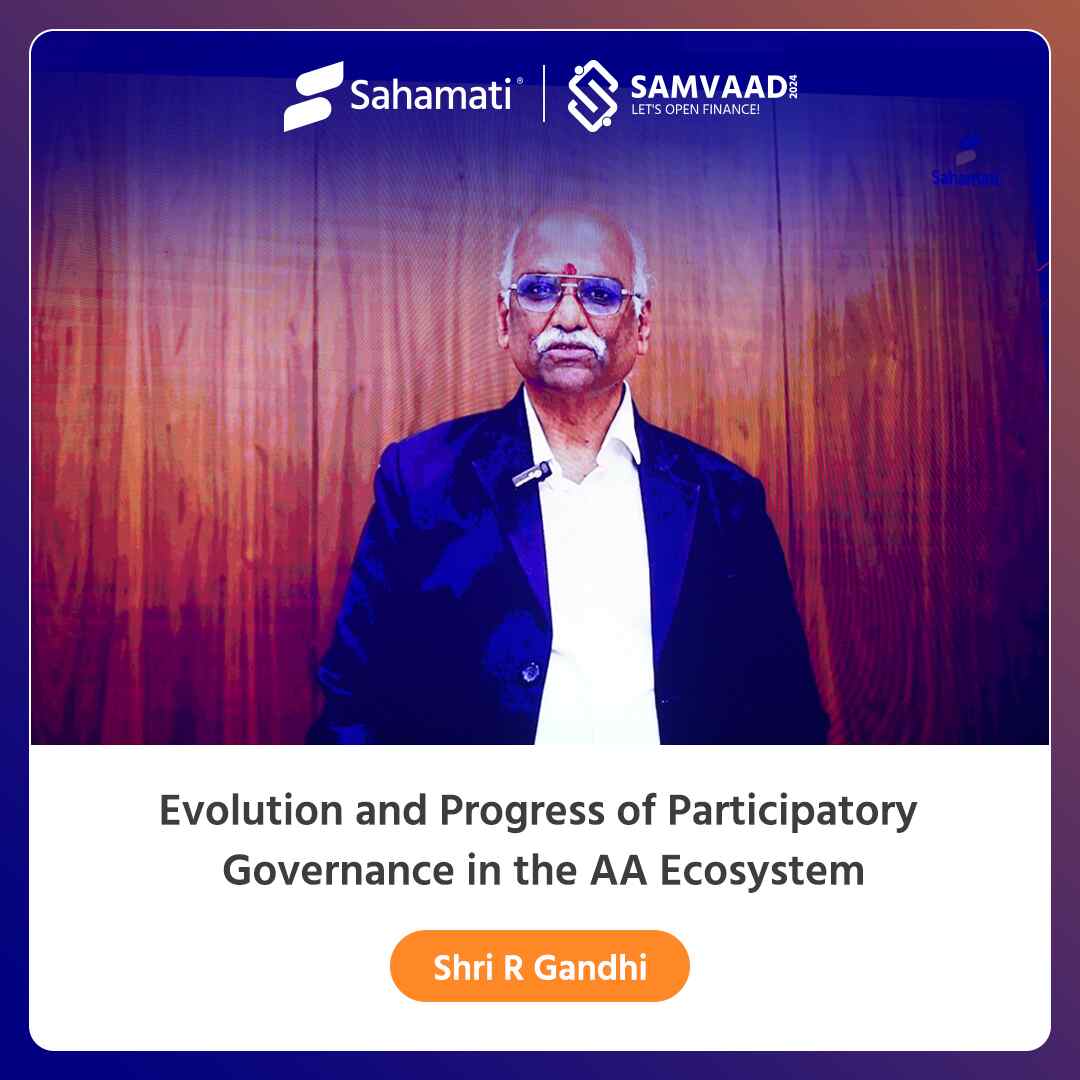“Evolution and Progress of Participatory Governance in the AA Ecosystem" by Shri R Gandhi
Introduction
Samvad 2024 gathered experts, innovators, and stakeholders from across the Indian financial landscape to discuss the evolution of the Account Aggregator (AA) framework. Among the distinguished voices, Shri R. Gandhi, former Deputy Governor of the Reserve Bank of India (RBI) and an integral member of Sahamati’s Advisory Council, shared his insights through a recorded video address. Although unforeseen circumstances prevented him from attending in person, his address left an indelible mark on the conference, focusing on the concept of participative governance and its relevance within the AA ecosystem.

1. Understanding the Uniqueness of the Indian Account Aggregator Model
Open Banking vs. Account Aggregation
Shri R. Gandhi began by setting the context of open banking around the world:
- In the EU and UK, “open banking” primarily refers to fintechs accessing customer banking information—restricted to banks and reliant on customer consent.
- In places like the USA, Japan, Singapore, Hong Kong, and Australia, variations of open banking are in effect.
In contrast, India has forged its own path with an independent, specialized Account Aggregator model. This exclusive entity stands apart from both data providers and data users, mandated specifically to serve the consumer’s interest. The AA:
- Acts as a neutral intermediary between Financial Information Providers (FIPs) (like banks, insurance companies, and mutual fund houses) and Financial Information Users (FIUs) (like lenders, fintechs, and wealth management companies).
- Must be entirely independent and cannot perform any other business apart from account aggregation services.
- Is empowered to function on customer consent, thus placing the consumer at the heart of the data-sharing process.
2. Broadening the Scope Beyond Traditional Finance
When it launched, the Indian AA system included banks, securities depositories, insurance firms, pension funds, and other financial institutions. However, Shri R. Gandhi highlighted how India’s model goes well beyond conventional banking data:
- GSTN (Goods and Services Tax Network) was integrated, offering a rich source of business-related information.
- There are ongoing talks and visions to include direct tax data, utility bill data, and even health information under the same umbrella.
This expansion into all spheres of economic and personal data underscores the system’s ambition and versatility. Ultimately, the Indian AA ecosystem strives to provide a comprehensive platform for seamless, consent-based data sharing.
3. The Need for Participative Governance
The AA ecosystem thrives on multiple stakeholders—FIPs, FIUs, Account Aggregators themselves, technical service providers, and government entities. Coordinating this wide array of participants calls for a robust governance framework. Shri R. Gandhi outlined three traditional governance models often seen in industry associations:
- Cooperative Principle
- “One member, one vote” system.
- Equal rights for all members, regardless of economic investment or size.
- Corporate Governance
- Governance rights hinge on economic contributions.
- Those who invest more may have more significant control or voting power.
- Participative Governance
- Each stakeholder—big or small—has an equal seat at the table.
- All views are heard, and consensus-building is key.
- Encourages collaboration, cooperation, trust, and mutual interdependence.
Shri R. Gandhi underscored “participative governance” as the ideal approach for India’s AA framework. Because the ecosystem involves diverse organizations with different capacities, only by working together can they ensure that everyone progresses and benefits.
4. Why Participative Governance Matters
- Collaboration Over Competition: While FIPs and FIUs may typically compete in certain areas, a cooperative network focuses on shared best practices, standards, and protocols.
- Big and Small Players Working Together: Large institutions often invest more resources, while smaller entities bring agility and niche expertise. Participative governance aligns these contributions so that the entire ecosystem can thrive.
- Consumer-Centric Values: The AA system’s foundation rests on serving consumer interests—by fostering trust, data security, and convenience. Participative governance ensures everyone is accountable to these principles.
5. A Vision for the Future
Shri R. Gandhi noted how Sahamati—the collective of Account Aggregator ecosystem stakeholders—has been championing the idea of participative governance. Through continuous dialogue, regular meetings, and consensus-building, the goal is to establish a sustainable and dynamic model that accommodates evolving use cases (like health and utility data) without compromising on the core tenets of data privacy, consumer consent, and security.
Key Takeaways
- Indian AA as a Global Trendsetter: The model goes beyond standard open banking to integrate broader economic data.
- Participative Governance is Key: Ensuring every stakeholder’s voice is heard fosters innovation and trust.
- Continuous Expansion: Plans for tax, utility, and health data point to a future of holistic data-sharing services for consumers and businesses alike.
Conclusion
Shri R. Gandhi’s address at Samvad 2024 served as a clarion call for the next phase of India’s Account Aggregator system. By embracing participative governance, stakeholders can collaboratively shape the ecosystem into a robust, inclusive, and future-forward platform. The ultimate beneficiaries? Indian consumers and businesses, who stand to gain unparalleled access, transparency, and convenience in data-driven financial services—and beyond.
As we move forward, the key to unlocking the full potential of the AA framework lies in cooperation, mutual trust, and a steadfast commitment to the consumer’s best interests. Indeed, the future of India’s financial technology landscape looks brighter than ever.
Related readings
